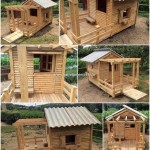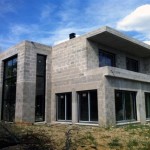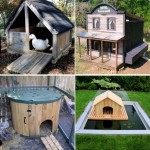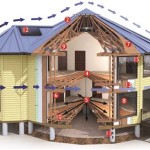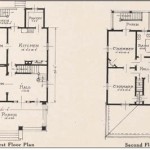Victorian-style house plans are architectural blueprints that outline the design and layout of a house in the Victorian architectural style. Victorian architecture, popular during the reign of Queen Victoria in the 19th century, is characterized by its elaborate ornamentation, steeply pitched roofs, and bay windows. An example of a Victorian-style house plan is the Queen Anne floor plan, which features a complex asymmetrical facade, wraparound porch, and intricate woodwork.
These plans provide a detailed guide for constructing a Victorian-style home, specifying the dimensions, materials, and aesthetic elements to be used. They encompass various architectural styles within the Victorian era, including Gothic Revival, Italianate, and Second Empire, each possessing unique characteristics.
In the following sections, we will delve into the intricacies of Victorian house plans, exploring their historical significance, architectural features, and modern adaptations.
Victorian-style house plans are renowned for their distinctive architectural features. Here are eight crucial points to consider when exploring these plans:
- Asymmetrical Facades: Irregular and visually appealing exterior designs
- Steeply Pitched Roofs: Prominent and often adorned with decorative elements
- Bay Windows: Projecting windows that create additional space and enhance natural light
- Elaborate Ornamentation: Intricate details such as gingerbread trim, fretwork, and stained glass
- Gothic Influences: Pointed arches, vaulted ceilings, and stained glass windows
- Italianate Influences: Round arches, symmetrical facades, and overhanging eaves
- Second Empire Influences: Mansard roofs, dormer windows, and elaborate ornamentation
- Modern Adaptations: Contemporary interpretations that blend Victorian elements with modern amenities
Understanding these key points will provide a deeper appreciation for the architectural nuances of Victorian-style house plans.
Asymmetrical Facades: Irregular and visually appealing exterior designs
Asymmetrical facades are a defining characteristic of Victorian-style house plans. They break away from the traditional symmetrical designs, creating a more dynamic and visually interesting exterior. This asymmetry is achieved through the varied placement of windows, doors, and other architectural elements, resulting in a unique and eye-catching appearance.
- Varied Window Placement: Victorian-style house plans often feature windows of different sizes and shapes arranged in an asymmetrical pattern. This creates a sense of visual rhythm and interest, as the eye is drawn to the varying heights and widths of the windows.
- Off-Center Doors: The front door is not always placed in the center of the facade. Instead, it may be shifted to one side or positioned within a projecting bay window. This off-center placement adds visual intrigue and creates a more inviting entryway.
- Projecting Elements: Bay windows, porches, and towers are common projecting elements that contribute to the asymmetrical design of Victorian-style houses. These elements break up the flat facade and create depth and shadow, enhancing the overall visual appeal.
- Varying Rooflines: Victorian-style houses often have complex and asymmetrical rooflines. Different sections of the house may have varying heights, slopes, and roof shapes, adding visual interest and architectural intrigue.
Overall, asymmetrical facades are a key feature of Victorian-style house plans, creating a visually dynamic and distinctive exterior design that sets these homes apart from other architectural styles.
Steeply Pitched Roofs: Prominent and often adorned with decorative elements
Steeply pitched roofs are a defining characteristic of Victorian-style house plans. These roofs not only add architectural interest but also serve practical purposes, such as shedding water and snow effectively. The steep slope of the roof also allows for the creation of spacious attics that can be utilized as living spaces or storage areas.
Victorian-style house plans often incorporate a variety of roof shapes, including gable roofs, hip roofs, and mansard roofs. Gable roofs are the most common type, featuring two sloped sides that meet at a ridge. Hip roofs have four sloped sides that meet at a central point, creating a more pyramidal shape. Mansard roofs are characterized by their double slope, with a steeper lower slope and a flatter upper slope.
In addition to their functional benefits, steeply pitched roofs in Victorian-style house plans are often adorned with decorative elements that enhance their visual appeal. These decorative elements can include:
- Gingerbread Trim: Ornate wooden trim featuring intricate cutouts and decorative patterns.
- Fretwork: Decorative openwork designs cut into wood or metal.
- Finials: Decorative ornaments placed at the peak of a roof or dormer.
- Cupola: A small, dome-shaped structure with windows, often placed on top of a roof for ventilation or as a decorative element.
These decorative elements add a touch of elegance and charm to Victorian-style houses, making them visually distinctive and architecturally appealing.
Bay Windows: Projecting windows that create additional space and enhance natural light
Bay windows are a prominent feature in Victorian-style house plans. These projecting windows extend outward from the main wall of the house, creating a more spacious and light-filled interior.
- Increased Space: Bay windows add extra square footage to a room, making it feel more spacious and airy. This additional space can be used for a variety of purposes, such as creating a cozy reading nook, displaying plants, or simply enjoying the view.
- Enhanced Natural Light: The large windows of a bay window allow for an abundance of natural light to flood into the room. This natural light not only creates a more cheerful and inviting atmosphere but also reduces the need for artificial lighting, saving energy.
- Improved Ventilation: Bay windows often feature multiple operable windows, which allows for increased ventilation. This is especially beneficial in warmer climates, as it allows for cross-ventilation to cool down the house.
- Architectural Interest: Bay windows add visual interest and architectural detail to the exterior of a Victorian-style house. The projecting shape and multiple windows create a unique and eye-catching feature that sets the house apart from others.
Overall, bay windows are a valuable addition to Victorian-style house plans, providing both functional and aesthetic benefits. They create more spacious and light-filled interiors, improve ventilation, and add architectural interest to the exterior of the house.
Elaborate Ornamentation: Intricate details such as gingerbread trim, fretwork, and stained glass
Victorian-style house plans are renowned for their elaborate ornamentation, which adds a touch of elegance and charm to these homes. Three common types of ornamentation found in Victorian-style houses are gingerbread trim, fretwork, and stained glass.
Gingerbread Trim
Gingerbread trim is a type of decorative woodwork that features intricate cutouts and patterns. It is often used to adorn the eaves, gables, and porches of Victorian-style houses. Gingerbread trim can be simple or elaborate, with some examples featuring whimsical designs such as animals, flowers, and geometric shapes.
Fretwork
Fretwork is another type of decorative woodwork that is characterized by its openwork designs. It is often used to create decorative panels, screens, and grilles. Fretwork can be made from a variety of materials, including wood, metal, and plastic. In Victorian-style houses, fretwork is often used to adorn the porches, balconies, and interior walls.
Stained Glass
Stained glass is a type of decorative glass that is created by adding metallic oxides to the glass mixture. This process creates vibrant colors and intricate designs. Stained glass is often used to create windows, skylights, and other decorative elements in Victorian-style houses. The colorful and ornate stained glass adds a touch of beauty and elegance to these homes.
Overall, the elaborate ornamentation found in Victorian-style house plans is a key element that sets these homes apart from other architectural styles. The intricate details and vibrant colors of gingerbread trim, fretwork, and stained glass add a touch of charm and elegance to these beautiful homes.
Gothic Influences: Pointed arches, vaulted ceilings, and stained glass windows
Gothic influences are evident in many Victorian-style house plans, adding a touch of medieval charm and grandeur to these homes.
- Pointed Arches: Pointed arches are a hallmark of Gothic architecture, and they are often used in Victorian-style houses to create a sense of height and drama. These arches can be found in doorways, windows, and even interior walls, adding a touch of elegance and sophistication to the home.
- Vaulted Ceilings: Vaulted ceilings are another common feature of Gothic architecture, and they can be found in many Victorian-style houses. These ceilings add a sense of spaciousness and grandeur to a room, and they can be decorated with intricate moldings and other decorative elements to create a truly stunning effect.
- Stained Glass Windows: Stained glass windows are a beautiful and distinctive feature of Victorian-style houses. These windows are created by adding metallic oxides to the glass mixture, which creates vibrant colors and intricate designs. Stained glass windows can be found in a variety of locations in Victorian-style houses, including windows, doors, and even skylights. They add a touch of color and elegance to the home, and they can also be used to create a sense of privacy.
- Other Gothic Influences: In addition to the three main elements listed above, there are a number of other Gothic influences that can be found in Victorian-style house plans. These influences can include things like steeply pitched roofs, turrets, and decorative bargeboards. These elements all contribute to the overall Gothic aesthetic of these homes, and they help to create a sense of grandeur and drama.
Overall, the Gothic influences found in Victorian-style house plans add a touch of medieval charm and elegance to these homes. These influences can be seen in a variety of architectural elements, including pointed arches, vaulted ceilings, and stained glass windows. By incorporating these elements into their designs, Victorian-style house plans create a unique and visually appealing aesthetic that is sure to impress.
Italianate Influences: Round arches, symmetrical facades, and overhanging eaves
Italianate architecture, popular during the Victorian era, is characterized by its symmetrical facades, round arches, and overhanging eaves. These influences are evident in many Victorian-style house plans, adding a touch of Italian charm and sophistication to these homes.
Round Arches
Round arches are a hallmark of Italianate architecture, and they can be found in a variety of locations in Victorian-style houses, including doorways, windows, and even interior walls. These arches add a sense of elegance and grandeur to the home, and they can be decorated with intricate moldings and other decorative elements to create a truly stunning effect.
Symmetrical Facades
Symmetrical facades are another common feature of Italianate architecture, and they are often used in Victorian-style houses to create a sense of balance and harmony. These facades are characterized by their central entrance, which is flanked by matching windows on either side. The overall effect is one of symmetry and order, which gives the home a stately and elegant appearance.
Overhanging Eaves
Overhanging eaves are a practical and decorative feature of Italianate architecture. These eaves help to protect the home from the elements, and they can also add a touch of visual interest to the exterior. In Victorian-style houses, overhanging eaves are often decorated with intricate brackets and other decorative elements, which add to the overall charm and character of the home.
Other Italianate Influences
In addition to the three main elements listed above, there are a number of other Italianate influences that can be found in Victorian-style house plans. These influences can include things like balustrades, quoins, and pediments. These elements all contribute to the overall Italianate aesthetic of these homes, and they help to create a sense of grandeur and sophistication.
Overall, the Italianate influences found in Victorian-style house plans add a touch of Italian charm and elegance to these homes. These influences can be seen in a variety of architectural elements, including round arches, symmetrical facades, and overhanging eaves. By incorporating these elements into their designs, Victorian-style house plans create a unique and visually appealing aesthetic that is sure to impress.
Second Empire Influences: Mansard roofs, dormer windows, and elaborate ornamentation
Mansard Roofs
Mansard roofs are a distinctive feature of Second Empire architecture, and they are often used in Victorian-style house plans to create a sense of grandeur and elegance. These roofs are characterized by their double slope, with a steeper lower slope and a flatter upper slope. The lower slope is typically pierced by dormer windows, which add natural light and ventilation to the upper floor. Mansard roofs can be constructed from a variety of materials, including slate, metal, and asphalt shingles. They are often decorated with intricate moldings and other decorative elements, which add to their overall visual appeal.
Dormer Windows
Dormer windows are another common feature of Second Empire architecture, and they are often used in Victorian-style house plans to add natural light and ventilation to the upper floor. These windows are typically placed on the lower slope of a mansard roof, and they can be either rectangular or arched in shape. Dormer windows can be simple or elaborate, with some examples featuring decorative moldings, pediments, and other architectural details. They add a touch of visual interest to the exterior of the home, and they can also help to increase the overall value of the property.
Elaborate Ornamentation
Elaborate ornamentation is a key characteristic of Second Empire architecture, and it can be found in a variety of locations in Victorian-style house plans, including the roofline,, windows, and doors. This ornamentation can take many forms, including moldings, brackets, pediments, and finials. It is often used to create a sense of grandeur and elegance, and it can help to make the home stand out from its neighbors. In some cases, the ornamentation may be inspired by historical styles, such as the Renaissance or Baroque periods.
Other Second Empire Influences
In addition to the three main elements listed above, there are a number of other Second Empire influences that can be found in Victorian-style house plans. These influences can include things like quoins, balustrades, and porches. These elements all contribute to the overall Second Empire aesthetic of these homes, and they help to create a sense of grandeur and sophistication.
Overall, the Second Empire influences found in Victorian-style house plans add a touch of French elegance and sophistication to these homes. These influences can be seen in a variety of architectural elements, including mansard roofs, dormer windows, and elaborate ornamentation. By incorporating these elements into their designs, Victorian-style house plans create a unique and visually appealing aesthetic that is sure to impress.
Modern Adaptations: Contemporary interpretations that blend Victorian elements with modern amenities
Modern adaptations of Victorian-style house plans blend the classic architectural elements of the Victorian era with contemporary design principles and modern amenities. These adaptations create homes that are both stylish and functional, with the charm of Victorian architecture and the convenience of modern living.
- Open Floor Plans: Traditional Victorian homes often had compartmentalized floor plans, with separate rooms for different functions. Modern adaptations often feature open floor plans that create a more spacious and airy feel. These open floor plans allow for greater flexibility in furniture arrangement and make it easier for families to interact and entertain.
- Updated Kitchens and Bathrooms: Kitchens and bathrooms in Victorian-style homes were often small and cramped, with limited amenities. Modern adaptations update these spaces with modern fixtures, appliances, and finishes. This creates more functional and comfortable spaces that meet the needs of today’s families.
- Energy Efficiency: Victorian-style homes were not typically designed with energy efficiency in mind. Modern adaptations incorporate energy-efficient features such as double-paned windows, insulated walls, and high-efficiency appliances. These features help to reduce energy consumption and lower utility bills.
- Smart Home Technology: Modern adaptations of Victorian-style house plans often include smart home technology that enhances convenience and security. This technology can include things like smart lighting, smart thermostats, and smart security systems. These features allow homeowners to control their homes remotely and automate tasks, making their lives easier and more secure.
Overall, modern adaptations of Victorian-style house plans offer the best of both worlds. They combine the charm and elegance of Victorian architecture with the functionality and convenience of modern living. These homes are ideal for those who appreciate the beauty of Victorian design but also want a home that meets the needs of today’s families.









Related Posts

